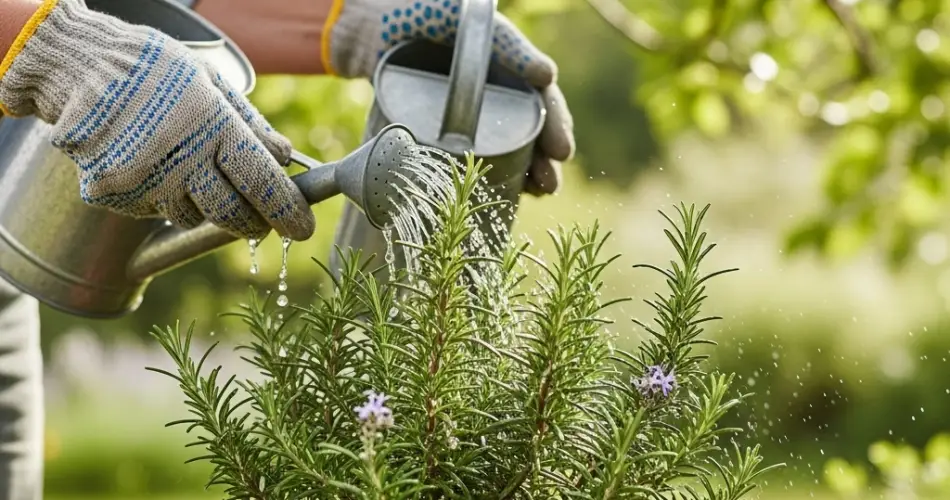Rosemary (Salvia rosmarinus) is a hardy, aromatic herb known for its pine-like scent, flavorful leaves, and drought-tolerant nature. Native to the Mediterranean, rosemary thrives in dry, rocky environments with lots of sun and very little water. While many gardeners assume that regular watering is necessary for herbs, rosemary is a notable exception. In fact, overwatering is one of the most common mistakes that leads to unhealthy plants or even root rot.
Understanding rosemary’s natural growing conditions and how it responds to moisture can help you cultivate a more resilient and productive plant — with far less water than you might expect.
1. Mediterranean Roots: Built for Dry Conditions
Rosemary evolved in the coastal regions of the Mediterranean, where the soil is often sandy and well-drained, and rainfall is infrequent. The plant developed thick, leathery leaves that retain moisture efficiently and a deep root system that allows it to survive long periods of drought.
Because of this natural adaptation, rosemary is capable of thriving in dry soil and doesn’t need the same frequent watering as thirstier herbs like basil or cilantro. Mimicking its native habitat is the key to keeping it healthy.
2. The Dangers of Overwatering
Too much water is more dangerous to rosemary than too little. Unlike tropical plants that need consistently moist soil, rosemary is highly sensitive to soggy conditions. When its roots sit in waterlogged soil, they can’t breathe, leading to root rot — a fungal infection that often kills the plant.
Signs of overwatering include:
-
Yellowing leaves
-
Droopy stems
-
Moldy or blackened roots
-
A musty smell around the base of the plant
If your rosemary is showing these symptoms, reduce watering immediately and improve soil drainage.
3. How Much Water Does Rosemary Really Need?
For most climates, rosemary only needs to be watered:
-
Once every 1 to 2 weeks during warm, dry months
-
Even less frequently in cool or humid conditions
-
Not at all during rainy periods if planted in the ground
The best way to know when to water is by checking the soil. Stick your finger into the soil about an inch deep. If it feels completely dry, it’s time to water. If there’s any moisture, wait a few more days.
Potted rosemary will dry out faster than in-ground plants, so check more often, especially during hot weather.
4. Use the Right Soil for Low-Water Needs
Rosemary’s ability to thrive with minimal water depends heavily on the type of soil it grows in. Good drainage is crucial.
For best results:
-
Use sandy or gritty soil that doesn’t retain too much moisture.
-
Add coarse sand, perlite, or small gravel to improve drainage if your native soil is clay-heavy.
-
In containers, choose a cactus or succulent mix or create a custom blend of potting soil and sand.
Avoid dense, water-retentive soils that stay soggy for long periods — rosemary’s roots prefer quick-draining conditions.
5. Sunlight Reduces Water Needs
Full sunlight not only promotes strong rosemary growth but also reduces the risk of overwatering. In sunny locations, soil dries out faster, which helps prevent root rot.
Aim to give your rosemary at least 6 to 8 hours of direct sunlight per day. The more sun it gets, the stronger and more aromatic the plant will become. Indoors, place pots on the sunniest windowsill or under a grow light if natural light is limited.
6. Mulch Carefully to Avoid Moisture Buildup
While mulch can help conserve moisture in hot weather, it can also trap too much water around rosemary’s roots if applied incorrectly.
If you choose to mulch:
-
Use light, dry materials like straw or shredded bark.
-
Keep mulch a few inches away from the base of the plant to allow air circulation.
-
Avoid using compost or moist mulch that retains excess water.
7. Adjust Watering Based on the Season
Rosemary’s watering needs vary by season. In hot, dry summers, it may need a little more frequent watering, especially in pots. In contrast, during cooler months, rosemary goes semi-dormant and requires very little moisture.
In winter:
-
Water only when the soil is bone dry.
-
Reduce watering drastically for indoor plants to prevent mold and rot.
-
Outdoor rosemary in rainy climates often needs no supplemental water at all.
Final Tips
-
Terracotta pots are ideal for rosemary because they allow moisture to evaporate more easily than plastic containers.
-
Always empty saucers under pots to prevent standing water from soaking the roots.
-
If you’re unsure whether to water, it’s often better to wait — rosemary is far more forgiving of drought than excess moisture.
In short, rosemary’s drought-hardy nature makes it a perfect choice for low-maintenance gardens and water-wise landscapes. By respecting its need for dry conditions, choosing the right soil, and avoiding overwatering, you can enjoy lush, aromatic rosemary with minimal effort — and minimal water.



